If you’re thinking about adding a vibrant, distinctive betta fish to your collection, a Koi betta could be an excellent choice. Despite having shorter fins compared to other bettas, their unique coloration makes them a standout. The beautiful marbled patterns of both males and females can add a splash of color to any aquarium.
This article provides comprehensive information about the color variations, behavior, lifespan, and care of Koi Betta. Everything you need to know is contained within this post!
Koi Betta Fish Quick Fact Table
| Common Names | Koi Betta |
| Scientific Name | Betta splendens (though specific for Koi variety could vary) |
| Adult Size | Approx. 2.5 to 3 inches |
| Lifespan | 3-5 years |
| Family | Osphronemidae |
| Origin | Southeast Asia (koi variant is selectively bred) |
| Temperament | Generally aggressive toward other bettas |
| Compatibility | Best kept alone or with non-aggressive species |
| Tank Mates | Kuhli Loaches, Bristlenose Plecos, Harlequin Rasboras, Otocinclus, Cory Catfish |
| Minimum Tank Size | 2.5 – 5 gallons (larger is better) |
| Diet | Carnivorous |
| Prey | Insects, small crustaceans |
| Habitat | Freshwater |
| Color | Varied (specific to koi pattern) |
| Skin Type | Scales |
| Care Level | Intermediate |
| Breeding | Bubble nesting |
| pH | 6.5 – 7.5 |
| Water Hardness | Soft to slightly hard |
| Temperature | 76 – 82°F (24 – 28°C) |
| Favorite Food | Live or frozen foods like brine shrimp or bloodworms |
Koi Betta Summary
Koi bettas are not a blend of koi and betta fish but fall under the Betta splendens category. Their distinct coloration, reminiscent of treasured koi, sets them apart.
This variety was accidentally discovered in the 1970s by Orville Gulley, an inmate at Indiana State Prison, during a rehabilitation project using peanut butter jars for breeding. Once recognized, they were introduced to the world by hobbyist Walt Maurus.
Though pricier, their stunning appearance makes them a prized choice for aquarium enthusiasts.
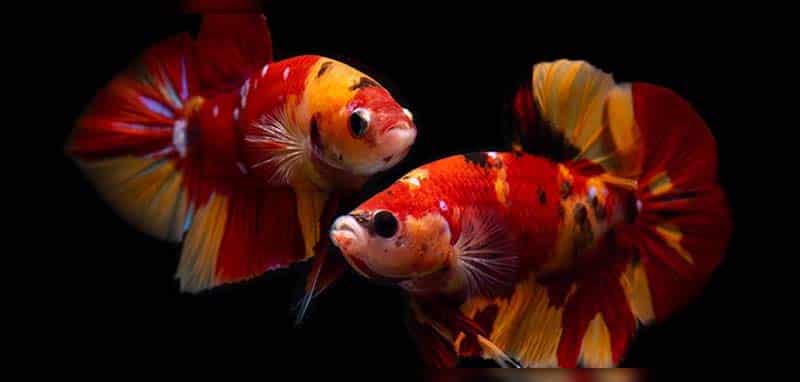
Koi Betta Appearance
Koi bettas stand out in the world of fish for their unique and varied markings. While marble bettas typically exhibit two marbled shades over their base color, Koi bettas can proudly boast up to three.
These stunning creatures are adorned with Koi-like patterns in a rich spectrum of black, white, orange, red, and sometimes blue. Male Koi bettas can flaunt either long or short fins and are often seen with half-moon, plakat, delta, or veil tail fin types. On the other hand, female Koi bettas, like their betta counterparts, possess shorter fins but don’t lag in displaying vibrant hues.

It’s fascinating to note that a Koi betta’s color pattern can shift with changes in its environment, its mood, and as it ages.
Koi Betta Fish Varieties & Color Types
The Koi Betta showcases a captivating assortment of colors, patterns, and tail types, offering enthusiasts a stunning array of options to choose from:
Galaxy Koi Betta: The quintessential Galaxy Koi Betta is characterized by its shimmering, iridescent scales that evoke the beauty of the cosmos. These scales create an ethereal and captivating visual effect, setting them apart from other betta varieties.

Fancy Variety: Distinguished by their multifaceted appearance, Fancy Koi Bettas boast a minimum of three distinct colors that blend harmoniously, creating an eye-catching and intricate palette.
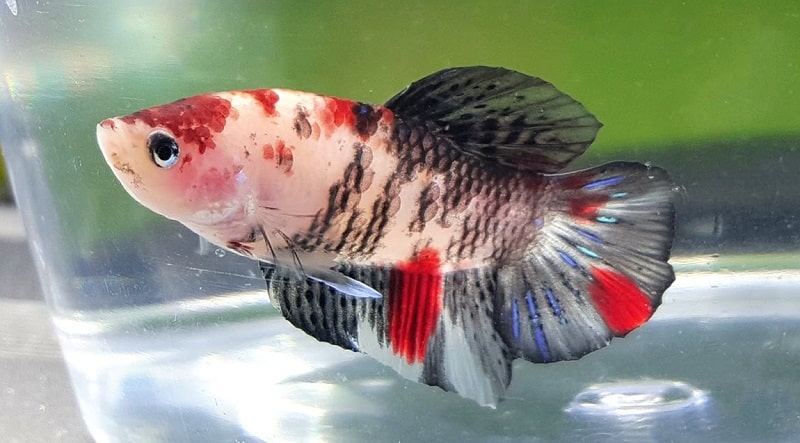
Candy Variant: The Candy Koi Betta exhibits vibrant and dazzling hues reminiscent of candies. Some liken their colors to the delightful shades found in sorbets, making them a visually delectable addition to any aquarium.
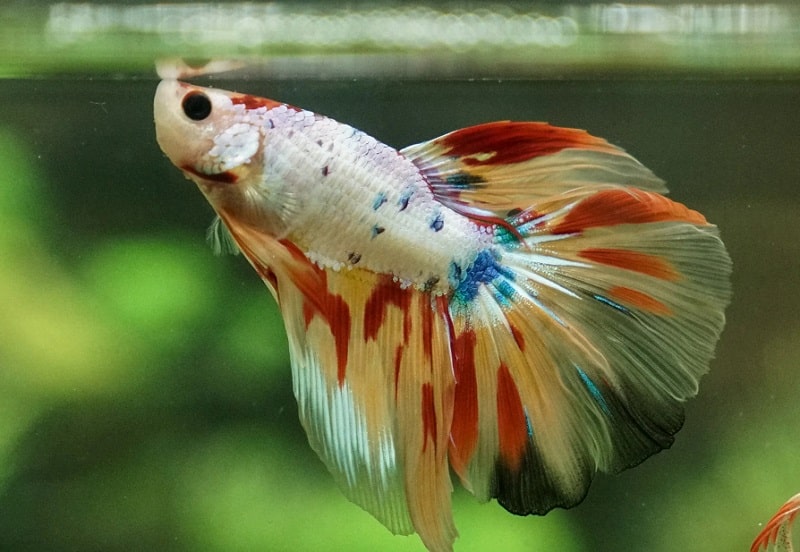
Tiger Stripes: The Tiger Koi Betta boasts a unique charm with its yellow-hued body adorned by striking black or blue stripes, evoking the powerful and majestic aura of its namesake.

Nemo Pattern: Aptly named after the beloved clownfish, the Nemo Koi Betta showcases a striking marbled pattern of orange, red, and black, reminiscent of the iconic fish from the sea.

Samurai Variation: A true rarity, the Samurai Koi Betta combines the allure of dragon scaling with marbled colors, creating a mesmerizing and intricate appearance that pays homage to the warrior spirit.
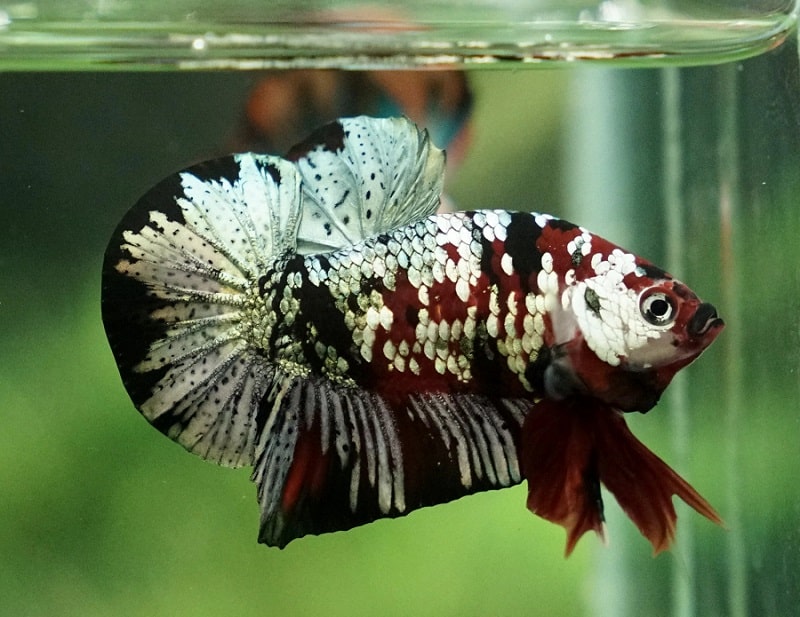
Veiltail Types: Beyond colors and patterns, the Tail Koi Bettas offer further diversity. Variations like crowntails and halfmoons are commonly found, each contributing to the betta’s unique charm. It’s essential to note that intricate fins can indicate a more delicate betta that requires attentive care.
Standard Koi Betta vs. Galaxy Koi Betta
A “Koi Betta” typically refers to a Betta fish with a color pattern resembling that of a Koi fish, usually displaying a mix of red, black, and white shades.
On the other hand, the “Galaxy Koi Betta” is a distinct variation with an extraordinarily vibrant and intricate color scheme. This includes hues of blue, red, white, orange, and black, arranged in patterns reminiscent of the mesmerizing swirls seen in galaxies. Moreover, this variant often boasts an iridescent, metallic glow on its scales, akin to shimmering stars in the night sky, which accentuates its “galactic” theme.
The standout feature of the “Galaxy Koi Betta” compared to the standard Koi Betta is this singular and striking color pattern.
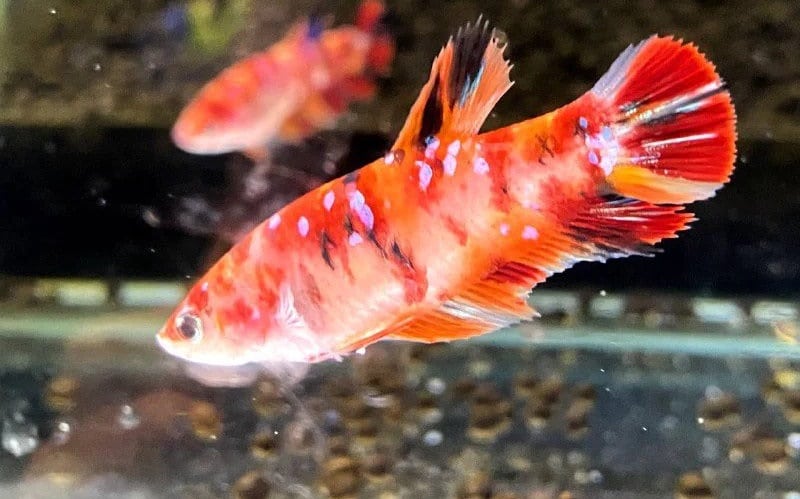
How To Tell If Koi Betta Is Male Or Female
- Fins: Thinner, sometimes shorter.
- Body: Streamlined.
- Egg Spot: White lump near ventral fins in adults.
- Color: Generally less bright.
- Head: Smaller in size.
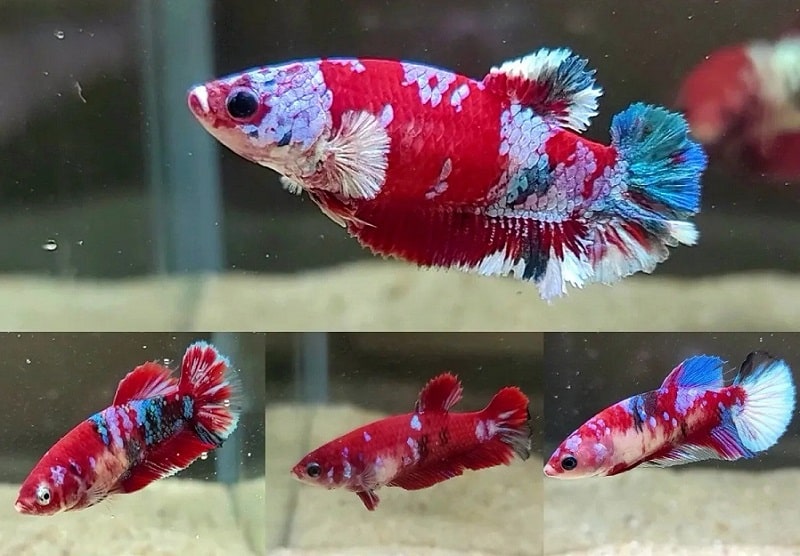
- Fins: Bulkier, especially ventral fins.
- Body: Curved, bulkier.
- Egg Spot: Not present.
- Color: Generally brighter.
- Head: Larger in size.
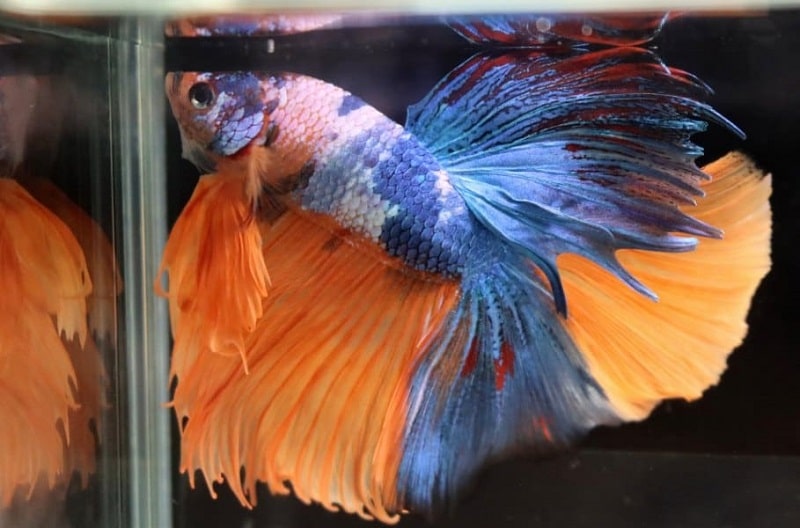
How Long Do Koi Betta Fish Live?
Koi bettas, like their Betta splendens counterparts, typically live for three to five years when provided with proper care.
However, their longevity greatly hinges on their living conditions. A high-quality diet, optimal tank environment, and attentive husbandry are essential. Neglect or subpar conditions can expose them to health issues, drastically reducing their lifespan. Proper care is paramount for a thriving koi betta.
How Big Do Koi Bettas Get?
Koi bettas are petite wonders. When they reach maturity, they typically measure between two and a half to three inches in length.
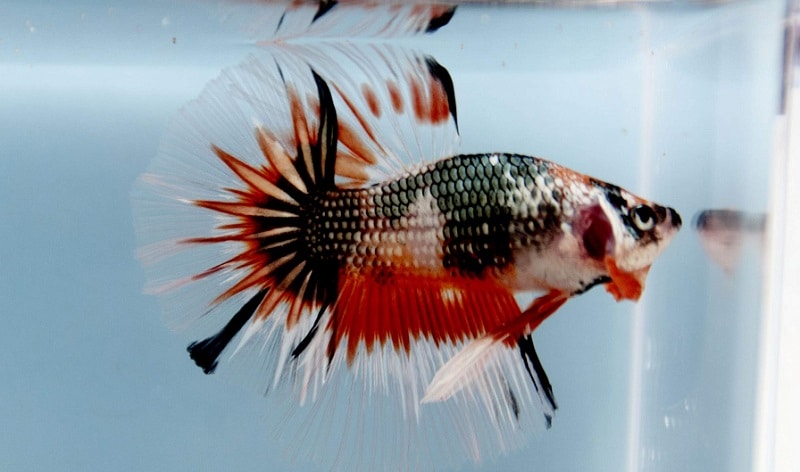
Koi Betta Fish Care
- Tank Size: It is strongly advised to provide your Koi Betta with a tank that holds at least 5 gallons of water. This ensures an environment where your betta can move freely and engage in natural behaviors.
- Temperature Range: Maintaining a consistent water temperature of 75–82˚F is vital for your Koi Betta’s well-being. Extremes below 75˚F or above 86˚F can lead to stress and health issues.
- pH Level: Strive for a neutral pH around 7.0, but understand that Koi Bettas can adapt to a slightly broader range of 6.0 to 8.0. Monitoring and stabilizing the pH helps create a comfortable habitat.
- Substrate: Opt for a substrate that supports plant growth and is gentle on your betta’s delicate fins. Smooth gravel or sand are excellent choices, while sharp materials should be avoided to prevent injuries.
- Plants: Incorporating live plants is not only visually appealing but also enhances the aquarium’s ecological balance. Suitable choices like mosses, dwarf hair grass, Anubias, Java ferns, and floating plants such as water lettuce provide hiding spots, oxygenation, and a more natural habitat.
- Lighting for betta: Emulate the natural day and night cycle by providing consistent lighting. Keeping a regular lighting schedule helps regulate your Koi Betta’s biological rhythms.
- Filtration: Employ a filtration system that maintains optimal water quality without creating strong currents. Clean water is crucial for your betta’s overall health, while excessive water movement can cause stress.

Koi Betta Breeding
By adhering to these comprehensive steps, you can participate in the wondrous process of nurturing new life within your aquarium, ensuring the health and vitality of your bettas at every stage.
- Set up a dedicated breeding tank equipped with a heater to maintain a stable temperature and a well-seeded sponge filter for biological filtration. Including a tank divider aids in acclimatizing the bettas to each other.
- House male and female bettas in separate tanks to maintain familiarity without the risk of aggression. Allow a period of around 2 weeks for the male and female bettas to acclimate to the breeding tank environment and to each other’s presence.
- The male will initiate the breeding process by constructing a bubble nest at the water’s surface. This elaborate structure serves as the future home for the eggs. After the female releases her eggs and the male fertilizes them, he carefully gathers the eggs and places them within the bubble nest. The female is then removed and returned to her separate tank.
- Once the eggs hatch into fry, it’s crucial to relocate the male back to his original tank to prevent accidental harm to the newborns.
Conclusion
Owning a Koi betta fish, which can serve as a stunning focal point in your aquarium and is suitable for beginners. Remember that your Koi betta could be a part of your life for 3–5 years, and some have even reached the age of 10 in captivity. Therefore, a strong dedication is required to maintain a healthy environment for your Koi betta fish and ensure its happiness.











